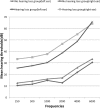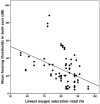Lowest Oxyhemoglobin Saturation May Be an Independent Factor Influencing Auditory Function in Severe Obstructive Sleep Apnea
- PMID: 26857050
- PMCID: PMC4865550
- DOI: 10.5664/jcsm.5786
Lowest Oxyhemoglobin Saturation May Be an Independent Factor Influencing Auditory Function in Severe Obstructive Sleep Apnea
Abstract
Study objectives: The aims of this study were to determine if a correlation exists between the level of hypoxia induced by severe obstructive sleep apnea syndrome (OSAS) and the level of auditory dysfunction when verifying such a relationship using polysomnography (PSG).
Methods: A retrospective review of 41 patients with severe OSAS was performed. Independent risk factors for hearing impairment included parameters of PSG, which were analyzed in two hearing groups at a level ≥ 40 decibels (dB).
Results: Oxyhemoglobin saturation, especially the lowest oxyhemoglobin saturation level, showed lower thresholds in the hearing impairment group than in the control group (p = 0.039 at NREM stage; p = 0.029 at REM stage; p = 0.001 at total sleep stage). After adjusting for other risk factors, the sole variable that remained significant was lowest oxyhemoglobin saturation (total; p = 0.046). In the correlation analysis, a decreasing lowest oxyhemoglobin saturation (from all subjects, n = 41) correlated with a greater mean hearing threshold (R(2) = 0.297; p < 0.001).
Conclusion: Our results indicated that lowest oxyhemoglobin saturation in PSG is the only variable correlated with the hearing threshold. This finding could be predictive of possible hearing alternation in patients with severe OSAS.
Commentary: A commentary on this article appears in this issue on page 641.
Keywords: obstructive sleep apnea; oxyhemoglobin saturation; polysomnography; sensorineural hearing loss.
© 2016 American Academy of Sleep Medicine.
Figures


Comment in
-
Can You Hear Me Now?J Clin Sleep Med. 2016 May 15;12(5):641-2. doi: 10.5664/jcsm.5780. J Clin Sleep Med. 2016. PMID: 27092694 Free PMC article. No abstract available.
Similar articles
-
Severity assessment of obstructive sleep apnea syndrome (OSAS) in pediatric patients.Clin Pediatr (Phila). 2009 Jun;48(5):528-33. doi: 10.1177/0009922809332584. Epub 2009 Feb 27. Clin Pediatr (Phila). 2009. PMID: 19252104
-
Serum levels of NGAL and cystatin C as markers of early kidney dysfunction in patients with obstructive sleep apnea syndrome.Sleep Breath. 2019 Mar;23(1):161-169. doi: 10.1007/s11325-018-1677-8. Epub 2018 Jun 26. Sleep Breath. 2019. PMID: 29946947
-
Erectile dysfunction and disease-specific quality of life in patients with obstructive sleep apnea.Int J Impot Res. 2008 Nov-Dec;20(6):549-53. doi: 10.1038/ijir.2008.39. Epub 2008 Sep 11. Int J Impot Res. 2008. PMID: 18997807
-
Comparison of the indices of oxyhemoglobin saturation by pulse oximetry in obstructive sleep apnea hypopnea syndrome.Chest. 2009 Jan;135(1):86-93. doi: 10.1378/chest.08-0057. Epub 2008 Aug 8. Chest. 2009. PMID: 18689584
-
Obstructive sleep apnea and cardiovascular disease.Mayo Clin Proc. 2004 Aug;79(8):1036-46. doi: 10.4065/79.8.1036. Mayo Clin Proc. 2004. PMID: 15301332 Review.
Cited by
-
Evaluation of auditory system in obstructive sleep apnea patients.Eur Arch Otorhinolaryngol. 2023 May;280(5):2201-2207. doi: 10.1007/s00405-022-07711-1. Epub 2022 Nov 9. Eur Arch Otorhinolaryngol. 2023. PMID: 36350365 Free PMC article.
-
[The research of the contralateral ear hearing thresholds and the hearing prognosis in unilateral Meniere's disease].Lin Chuang Er Bi Yan Hou Tou Jing Wai Ke Za Zhi. 2024 Apr;38(4):278-283. doi: 10.13201/j.issn.2096-7993.2024.04.003. Lin Chuang Er Bi Yan Hou Tou Jing Wai Ke Za Zhi. 2024. PMID: 38563168 Free PMC article. Chinese.
-
Auditory Function of Patients with Obstructive Sleep Apnea Syndrome: A Study.Eurasian J Med. 2020 Jun;52(2):176-179. doi: 10.5152/eurasianjmed.2019.18373. Epub 2020 Jun 4. Eurasian J Med. 2020. PMID: 32612427 Free PMC article.
-
Idiopathic Sudden Sensorineural Hearing Loss in Patients with Obstructive Sleep Apnea.Nat Sci Sleep. 2021 Oct 15;13:1877-1885. doi: 10.2147/NSS.S331880. eCollection 2021. Nat Sci Sleep. 2021. PMID: 34703345 Free PMC article.
-
Induced Short-Term Hearing Loss due to Stimulation of Age-Related Factors by Intermittent Hypoxia, High-Fat Diet, and Galactose Injection.Int J Mol Sci. 2020 Sep 25;21(19):7068. doi: 10.3390/ijms21197068. Int J Mol Sci. 2020. PMID: 32992845 Free PMC article.
References
-
- American Thoracic Society. Standards and indications for cardiopulmonary sleep studies in children. Am J Respir Crit Care Med. 1996;153:866–78. - PubMed
-
- Fletcher EC. The relationship between systemic hypertension and obstructive sleep apnea: facts and theory. Am J Med. 1995;98:118–28. - PubMed
-
- Hui DS, Wong TY, Ko FW, et al. Prevalence of sleep disturbances in Chinese patients with end-stage renal failure on continuous ambulatory peritoneal dialysis. Am J Kidney Dis. 2000;36:783–8. - PubMed
-
- Javaheri S, Parker TJ, Liming JD, et al. Sleep apnea in 81 ambulatory male patients with stable heart failure: types and their prevalences, consequences and presentations. Circulation. 1998;97:2154–9. - PubMed
MeSH terms
Substances
LinkOut - more resources
Full Text Sources
Other Literature Sources
Medical
Miscellaneous

